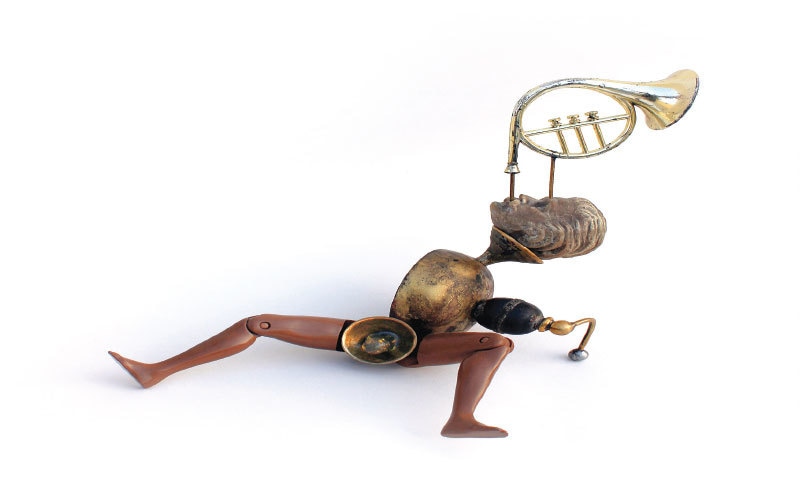Finding the setting of the production for any object is an essential process for many people. That ‘made in’ piece of information printed on the item can start investigations that trace the history, manufacturing processes and, perhaps, even the geographical routing of the object. This research becomes complex when an object is rooted in history, and production of art and design is a composite that is created with articles from different countries in the world.
You may now consider such amalgamated pieces, discover their interconnected trade routes and experience a wistful longingness of the past in the sculptural assemblages of Affan Baghpati. The artist’s latest exhibition at Aicon Contemporary in New York, titled ‘Anatomy of a Horny Heart’, welcomes viewers to ruminate over industrially produced objects from yesteryears. Select individuals now mostly desire these more for their unique aesthetic designs than as commodities.
To create these assemblages, Baghpati hunts European- and Pakistani-made or labelled objects that have previously passed through import-export channels via many owners, ultimately landing in open flea markets that often sell pre-owned items. Many of these items are made in different places than the locations suggested on the object.

The artist dissects and reassembles the collected paraphernalia in his studio, while also passing them through multiple iterations of processes including moulding and casting. Baghpati’s works have previously been exhibited in the country’s art galleries, and internationally, as in the case of this exhibition. The back-and-forth construction and deconstruction in these works juxtaposes new tiers of significance in these altered forms, which represent material cultures.
Affan Baghpati’s assemblages of cultural ‘readymades’ prompt a deeper understanding of object evolution and distribution, while evoking nostalgia for a bygone era
An example of material culture, that is the “absorption, consumption and trade of objects and their social influence” and interconnectivity between global paths can be observed in the work ‘Hold On’ (2020), a composite created by joining two objects.
The top of the assemblage is a partial ready-made surma [kohl] applicator, essentially part of a traditional kohl pot [surmadani] popular in India and Pakistan. The delicate object is made with brass in a gold finish and the word ‘Pakistan’ in Urdu can be made out lightly carved over the metal. The purposefully separated head of the applicator from its stick is a reoccurring object in many of Baghpati’s works.

The artist solders this piece to a small figurine of a male child, which is a mass-market reproduction of the Manneken Pis (‘The Pissing Boy’, originally made in 1619 by Jerome Duquesnoy the Elder). The Manneken is a bronze fountain sculpture and a symbol of the humour and independent thinking of the people of Brussels in Belgium.
While these objects may have been made anywhere in the world, the head of the Pakistan-labelled kohl applicator affixed to a European ornamental bottle opener offers multiple readings. Both objects offer aesthetic value and some utility but are now heralded as memorabilia. Through Baghpati’s hands, they turn into a single contemporary assembly that relies on their original forms while redacting their meaning through the artist’s studio processes and gallery exhibits, as this composite is now a product from multiple global sites.
Other works in the show include sliced animal figurines joined with partial objects, while some utilise popular collectibles — such as replicas of the ancient Greek sculpture Venus di Milo and the head of European music composers — in works such as A Long Embracing Dance Away (2021) and You Know I Love You (2021). Some works involve themes related to gender roles, desire, childbirth and reproduction as well.
For a younger generation, many works stir up memories of family seniors who would often use traditional objects such as surmadanis and paandaans [betel leaf containers]. On the side, Baghpati’s assemblages will urge you to explore traders’ markets, find such rarities and consider whether only their location of manufacturing is the most essential factor in determining their worth.
‘Anatomy of a Horny Heart’ was on display at Aicon Contemporary, New York, from May 1, 2021 till May 29, 2021
Published in Dawn, EOS, June 6th, 2021
















































Dear visitor, the comments section is undergoing an overhaul and will return soon.